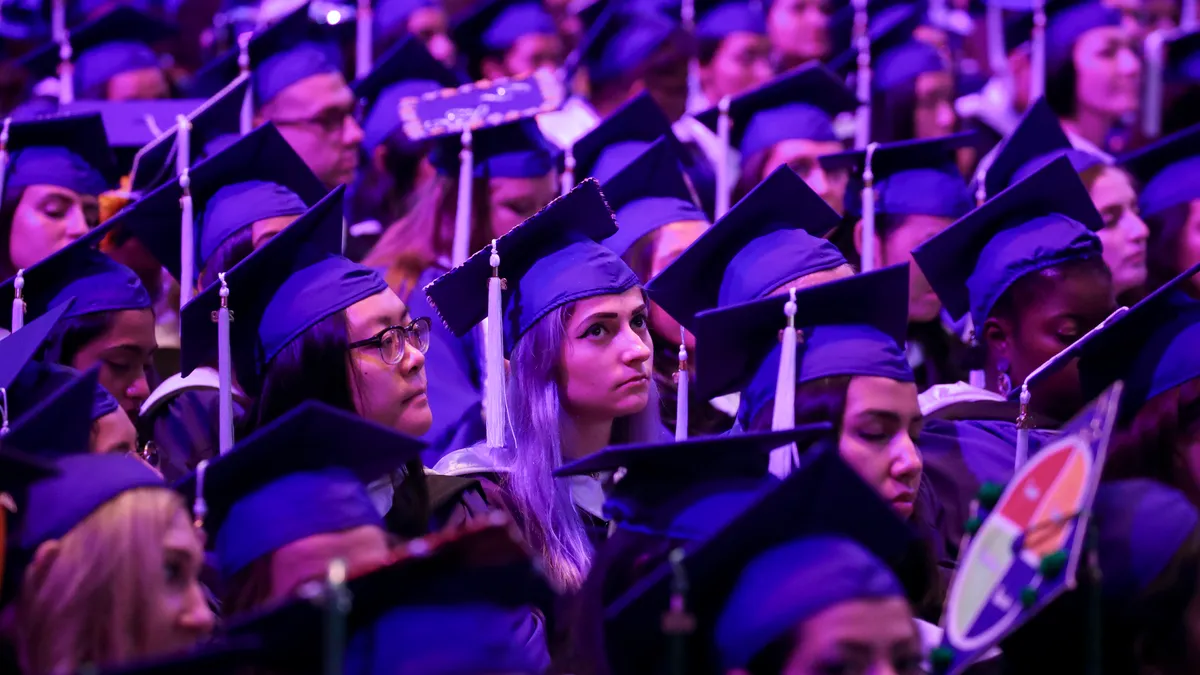Dive Brief:
- The six-year completion rate for undergraduates who started college in 2016 reached 62.3%, the highest level this decade but only 0.1 percentage point above the previous year’s cohort, according to a new report from the National Student Clearinghouse Research Center.
- The flat figure comes after the completion rate last year jumped 1.2 percentage points from the 2014 cohort to the 2015 cohort. This year’s rate also masks some concerning trends, including falling completion rates among White, Black and Latinx students.
- Institution types with the highest graduation rates saw declines among the 2016 cohort. Students starting at four-year public colleges had the largest decline, a 1 percentage point drop, lowering their completion rate to 68%. Completion rates for students starting at four-year private nonprofits declined 0.5 percentage points to 77.8%.
Dive Insight:
The flat completion rate follows years of steady increases, potentially signaling that colleges will have to work harder to continue raising the share of students who earn their diplomas.
Some institution types bucked the overall trend and saw completion rate increases. Students who started at community colleges in 2016 had a six-year completion rate of 43.1%, up 0.9 percentage points from the previous year’s cohort. Four-year for-profit colleges saw similar gains, with completion rates rising 1.2 percentage points to 47.6%.
Completion rates stalled for the 2016 cohort year
However, the report notes that some of these changes are due to colleges switching to different categories. From 2015 to 2016, 25 community colleges were reclassified as four-year institutions because, while they primarily grant associate degrees, they also offer some bachelor's programs. That change pulled down the completion rate of the four-year public sector and helped increase the completion rate of the community college sector, according to the report.
Among the fall 2016 cohort, only 8.9% of students are still enrolled, while more than one-quarter have left college without finishing their credentials.
“Today, out of all students who started college six years ago, 37.7% have yet to complete any degree or credential,” Doug Shapiro, the research center’s executive director, said in a statement. “With only 8.9% still working on it, the remaining 28.8% amounts to too many who are short of their dreams and left out of the educated workforce of the future.”
A little over half of states saw their completion rates improve, but most of these gains were less than 1 percentage point compared to the year before. However, five states saw their rate rise above 1 percentage point: Kentucky, Louisiana, Maryland, Rhode Island and Utah.
That’s in stark contrast to the 2015 cohort, whose completion rates rose by more than one percentage point in two-thirds of states.
The report also found differences among racial and ethnic groups.
Completion rates declined across all measured categories at public four-year colleges. However, it fell most steeply among Black students, whose rate declined by 1.1 percentage points to 50.2%, and Latinx students, whose rate fell by 3.2 percentage points to 57.1%. The report noted that the decline among Black students is entirely due to the reclassification of the 25 community colleges.
Completion rates for White students starting at public four-year colleges declined 0.8 percentage points to 73.5%.
A divide between male and female students is also growing. For the 2016 cohort, the male completion rate was 58.5%, compared to a 65.6% rate for women. That leaves a gap of 7.1 percentage points between the two groups — the highest it has been since the 2008 cohort.















